kibango
Wood with rich brown patina
Height 63in (160cm)
Provenance
Reportedly Charles Ratton, Paris
Private Collection, acquired in the early 1940s
Schwart Family Collection, Tintigny, Belgium
Pierre Dartevelle, acquired from the above in 1966
Published
Berjonneau, Gerald and Jean-Louis Sonnery, Rediscovered Masterpieces of African Art, Foundation Dapper, Art 135, Boulogne, 1987, fig. 284
Neyt, Francois, Luba - To the source of the Zaire, Musée Dapper, Paris, 1993, p. 119
Nooter Roberts, Mary and Allen F. Roberts, Memory - Luba Art and the Making of History, Prestel, New York, 1996, cat. no. 65
Exhibited
Paris, France, Luba. Aux sources du Zaïre, Musée Dapper, 25 November 1993 - 17 April 1994
Memory - Luba Art and the Making of History:
New York City, New York, The Museum of African Art, 2 February - 8 September 1996;
Washington, D.C., The National Museum of African Art, Smithsonian Institution, 30 October 1996 - 26 January, 1997;
Buffalo, New York, Albright-Knox Art Gallery, 26 July - 5 October 1977;
Wellesley, Massachusetts, Davis Museum & Cultural Center, Wellesley College, 5 February - 7 June 1998
Estimate on Request
An Anthropomorphic Luba-Tabwa Dignitary's Staff:
A rare emblem of prestige and authority from the Democratic Republic of Congo
By François Neyt
This exceptional dignitary's staff, which displays both Luba and Tabwa morphological traits, is a product of the Luba Kingdom, whose development in the 18th and 19th century warrants description here. Its stylistic characteristics indeed reveal Luba, Tabwa, and even Hemba influences, from a specific workshop and in a specific style. It will also be relevant to mention the role of feminine power among the kings and the chiefs who depended on it as well as that of the vidye spirits. These kibango staffs were of such great importance that few people had the right to see them, but no one was unaware of their existence. (Burton W.E.P., Luba Religion and Magic in Custom and Relief, Annales M.R.A.C., Sciences de l'homme n° 35, Tervuren, 1961, p.31; Neyt François, Luba. Aux sources du Zaïre, Musée Dapper, Paris, 1993, p.111-138)
Luba History in the 18th and 19th Centuries
The birth of the Luba Kingdom around the 16th century occurred in the middle of the Upemba Depression, among the Central Luba, more commonly known as the Luba Shankadi. The Luba Kasaï (Western Luba) inhabited the area west of them, and the Eastern Luba occupied the areas northern and eastern parts of the Upembo Depression. They extended their influence as far as Lake Moero by moving up the shores of the Luvua River and beyond the Lukuga River, which drains into Lake Tanganyika. Prince Buki, banished from the royal court by King Kumwimbe Ngombe (1810 to 1840), was sent to the north and the east of the kingdom. He took advantage of his situation to multiply the insignia of power in these places, and gave major local chiefs the right to own and use regalia, including staffs, caryatid stools, and ritual and ancestral effigies. The Tabwa, who inhabited the western shores of Lake Tanganyika, were among the groups that obtained these rights.
The Message Inscribed on the Figurative Staff
The staff is carved of medium density wood, and is 160 centimeters (63 inches) long. It has a light brown patina and is decorated at the center with a small wooden sphere that separates two long segments rendered as barber's pole spirals. This medial sphere is a sign of authority. There is no decoration at its upper extremity, but the upper third of the staff is a female figure rendered standing on an elongated and slightly concave rectangular base that has lozenge and triangle designs on all four of its sides and tapers as it extends downwards. These geometric motifs are among the feminine symbols that refer to the fertilization of the earth by the new moon. They also appear between the woman's breasts and the navel.
The majestic vidye spirit is rendered in a standing position. The face is finely modeled, the vigilant eyes are bordered by conspicuous diamond shapes, and the arms curve back to the shoulders on the bulbous body. The legs are delicately bent, and the prominent feet extend out beyond the base. Three isometric zones are apparent on the figure – from the coiffure to the base of the neck, from the shoulders to the genitals, and from the buttocks to the bottom of the base.
The coiffure is exceptional. The top of the forehead is extended by a high circular band clearly cut at an angle. This band is decorated with fine vertical rows of small diamond shapes and encircles the head. Superb bulging braids are intertwined at the top of the head into a large four-lobed bun, making the coiffure similar to one known among the Northern Hemba. Tradition has it that at the change of seasons the chief might keep the seeds under this coiffure. Among the Hemba, these seeds were kept in a square raffia bag.
Scarification marks are present beneath the small breasts on the cylindrical trunk while others frame the umbilical area with lattice shapes, and yet other even more prominent and parallel ones envelop the lower abdomen up to the bottom of the kidneys, which are surmounted by two repeated lines. The sex is clearly sculpted.
Feminine Power Associated with the Vidye Spirits
In the Luba Kingdom, bowstands, spears and staffs were the most important emblems of the Luba kings and chiefs. Mary H. Nooter has noted how scarifications, royal secrets, interdictions, and the gestures of female hands on the breasts signify the power and protection of the secrets kept by the king and his entourage of advisors, by his most trusted mother, and by the widows and sisters. Bowstands that were no longer being used were rarely shown in public, although they exercised great power. The number of spears and staffs was limited and their distribution was managed observing specific and clearly defined ritual precautions. (Secrecy, African Art that conceals and reveals, The Museum for African Art, New York, Prestel, Munich, 1993, cat. 37, p. 105)
The female figure, rendered standing, seated with her legs extended, or squatting or kneeling, is abundantly present in the Luba arts. She is there to transmit Luba life and traditions. Sculpting her entire body or her face was a profoundly spiritual act for it was through her representation that the beliefs and the history of a people were expressed. The sculptures are divided into three types: women and the sacred, women and politics, and women and everyday life. Indeed, she is the foundation and support for the energies and forces of the ancestral spirits that inhabit and roam the universe.
In the realm of the sacred, the female body is represented by cup bearers and precious sculptures that are very rare when one considers Luba production in its entirety. (Neyt François, Luba, opus citatus, p.150 sv.) They illustrate the woman and the vidye spirits, the forces of the cosmos and the presence of the ancestors. She is present in a wide variety of forms, an expression of contained strength and interiority, with a refined coiffure, her eyes often half-closed yet open to another world, displaying scarifications and sensual lines, her hands on her breasts, ready to receive the spirits, to attract them and to invoke their presence.
She is also a force, albeit in a secret way, in the kingdom's political life, as well as in that of the local chiefs and the villages. The objects that represent her in this function are the caryatid stools and the staffs. The latter are ritually given to the chiefs, and village heads at strategic locations like river crossings, a mountain or a spring. The staff we are considering here retains this both political and sacred dimension. It also displays characteristics that are typically Tabwa, like the diamond-shaped eyes and the hands that extend up onto the shoulders at the ends of arms that run up alongside the breasts. This sculpture can be dated to the middle of the 19th century and compared to other emblematic Luba figures. In conclusion, the woman was a ubiquitous presence in everyday life and acted as the guarantor of the present and of the future, while she simultaneously watched over the memory of the deceased kings and chiefs.
Sceptre Anthropomophe Luba-Tabwa:
Signe rare de prestige et d'autorité, République Démocratique du Congo
par François Neyt
Ce sceptre exceptionnel, portant les signes morphologiques luba et tabwa, s'inscrit dans l'histoire du Royaume luba dont l'évolution mérite d'être décrite aux XVIIIe et XIXe siècles. Ses traits stylistiques révèlent en effet les apports luba et tabwa et même hemba dans un atelier et un style déterminé. Il importe aussi de dévoiler le rôle du pouvoir féminin entre les rois et les chefs qui en dépendent ainsi que la place des génies vidye. Ces sceptres kibango ont une telle importance que peu de personnes ont le droit de les voir bien que nul n'ignore leur existence. (Burton W.E.P., Luba Religion and Magic in Custom and Relief, Annales M.R.A.C., Sciences de l'homme n° 35, Tervuren, 1961, p.31; Neyt François, Luba. Aux sources du Zaïre, Musée Dapper, Paris, 1993, p.111-138)
L'histoire luba aux XVIIIe et XIXe siècles
La naissance du royaume luba vers le XVIème siècle se développe au centre de la dépression de l'Upemba: ce sont les Luba centraux, plus connus sous le nom de Luba Shankadi. Les Luba Kasaï (Luba occidentaux) s'étendent vers l'ouest; les Luba orientaux habitent au nord et à l'est de la dépression de l'Upemba. Ils ont étendu leur influence jusqu'au lac Moero en remontant les rives de la Luvua et au-delà de la rivière Lukuga, exutoire du lac Tanganyika. Le prince Buki, exilé de la cour royale par le Roi Kumwimbe Ngombe (1810 à 1840), fut envoyé dans le nord et l'est du royaume. Il en profita pour y multiplier les signes de pouvoir, accordant aux grands chefs locaux de se parer des regalia: sceptres, sièges à caryatide, effigies cultuelles et ancestrales. Les Tabwa, occupant les rives occidentales du lac Tanganyika, en faisaient partie.
Le message inscrit sur le sceptre figuratif
Taillé dans un bois mi-lourd de 160 cm, ce sceptre à la patine d'un brun clair est décoré au centre d'une petite sphère de bois qui limite deux longs espaces décorés de spirales. Cette sphère médiane est un indice d'autorité. L'extrémité de la canne s'achève sans décoration; par contre, sur le tiers supérieur de la canne se déploie la figure féminine reposant sur un socle rectangulaire étiré, légèrement concave, parcouru sur les quatre faces d'un losange et de triangles. Ces motifs géométriques font partie de la symbolique féminine où la nouvelle lune vient féconder la terre. Ils apparaissent aussi entre les seins de la femme et le cercle ombilical.
La présence majestueuse de cet esprit vidye est en posture debout. Le visage finement modelé, les yeux vigilants sont bordés d'un losange saillant et sur le corps bulbeux, les bras se replient en courbe jusqu'aux épaules. Les jambes sont délicatement fléchies, les pieds en raquette débordent du socle. Trois isométries se mesurent de la coiffure jusqu'à la base du cou, du plan des épaules au sexe, du fessier jusqu'à la base du socle.
La coiffure est exceptionnelle. Le haut du front se prolonge d'un haut rebord circulaire nettement découpé en biais. Ce dernier est décoré de fines rangées verticales de petits losanges faisant le tour du crâne. De superbes tresses bombées au sommet s'entrecroisent en un ample chignon quadrilobé, proche des coiffures septentrionales des Hemba. Une tradition rapporte qu'au changement de saison le chef pouvait conserver les graines sous cette coiffure. Chez les Hemba, ces graines étaient disposées dans un sachet carré en raphia.
Sur le tronc cylindrique, les scarifications dominent sous de petits seins, d'autres encadrent la zone ombilicale de croisillons, d'autres encore plus saillantes et parallèles enveloppent le bas-ventre jusqu'au bas des reins surmontés de deux traits répétés. Le sexe est clairement sculpté.
Le pouvoir féminin lié aux génies vidye.
Dans le royaume luba, les porte-flèches, les lances et les sceptres constituent les emblèmes les plus importants des rois et des chefs luba. Mary H. Nooter note combien les scarifications, les secrets royaux, les interdits et les gestes des mains féminines posées sur les seins signifient le pouvoir et la protection des secrets gardés par le roi et par son entourage de conseillers, par sa mère la première écoutée, par les veuves et ses sœurs. Les porte-flèches qui ne sont plus en usage étaient rarement montrés en public, alors qu'ils exerçaient un grand pouvoir. Quant à la diffusion des lances et des sceptres, leur nombre était restreint et s'exerçait suivant des précautions rituelles fixées. (Secrecy, African Art that conceals and reveals, The Museum for African Art, New York, Prestel, Munich, 1993, cat. 37, p. 105)
Les arts luba illustrent à profusion le corps de la femme debout, assise jambes tendues, accroupie ou agenouillée. Elle est là pour transmettre la vie et les traditions luba. Sculpter son corps tout entier ou son visage est un acte relevant de la plus haute spiritualité, car à travers sa représentation se traduisent les croyances et l'histoire d'un peuple. Les sculptures se répartissent selon trois domaines: la femme et le sacré; la femme et le politique; la femme et le quotidien. En effet, elle est le support des énergies et des forces des esprits ancestraux qui habitent et traversent l'univers.
Dans le domaine du sacré, le corps féminin est représenté dans des porteuses de coupe et de précieuses statues très rares quand on considère l'ensemble de la production luba. (Neyt François, Luba, opus citatus, p.150 sv.) Elles illustrent la femme et les génies vidye, forces du cosmos et présence des ancêtres. Elle est présente dans une plénitude des formes, expression de force contenue et d'intériorité, coiffure raffinée, yeux souvent mi-clos ouverts sur un autre monde, scarifications et lignes sensuelles, mains sur les seins, prêtes à accueillir les esprits, à les attirer et à invoquer leur présence.
Elle est aussi à l'œuvre, de façon secrète, dans la vie politique du royaume, comme dans celle des chefs locaux et des villages. Ce sont précisément les sceptres et les sièges à caryatides. Les sceptres sont donnés rituellement à des chefs, gardiens de village, de lieux stratégiques, tels le franchissement d'une rivière, une montagne, une source d'eau. Le sceptre étudié garde cette empreinte politique et sacrée. Elle porte aussi des signes propres aux Tabwa comme les yeux en losange et les mains remontant au-dessus des épaules, à côté des seins. Elle peut être datée au milieu du XIXe siècle et comparée à d'autres emblèmes luba. Enfin, la femme se présente dans la vie de tous les jours comme la garante du présent et de l'avenir, tout en veillant sur la mémoire des rois et des chefs défunts.
kibango
Wood with rich brown patina
Height 63in (160cm)
Provenance
Reportedly Charles Ratton, Paris
Private Collection, acquired in the early 1940s
Schwart Family Collection, Tintigny, Belgium
Pierre Dartevelle, acquired from the above in 1966
Published
Berjonneau, Gerald and Jean-Louis Sonnery, Rediscovered Masterpieces of African Art, Foundation Dapper, Art 135, Boulogne, 1987, fig. 284
Neyt, Francois, Luba - To the source of the Zaire, Musée Dapper, Paris, 1993, p. 119
Nooter Roberts, Mary and Allen F. Roberts, Memory - Luba Art and the Making of History, Prestel, New York, 1996, cat. no. 65
Exhibited
Paris, France, Luba. Aux sources du Zaïre, Musée Dapper, 25 November 1993 - 17 April 1994
Memory - Luba Art and the Making of History:
New York City, New York, The Museum of African Art, 2 February - 8 September 1996;
Washington, D.C., The National Museum of African Art, Smithsonian Institution, 30 October 1996 - 26 January, 1997;
Buffalo, New York, Albright-Knox Art Gallery, 26 July - 5 October 1977;
Wellesley, Massachusetts, Davis Museum & Cultural Center, Wellesley College, 5 February - 7 June 1998
Estimate on Request
An Anthropomorphic Luba-Tabwa Dignitary's Staff:
A rare emblem of prestige and authority from the Democratic Republic of Congo
By François Neyt
This exceptional dignitary's staff, which displays both Luba and Tabwa morphological traits, is a product of the Luba Kingdom, whose development in the 18th and 19th century warrants description here. Its stylistic characteristics indeed reveal Luba, Tabwa, and even Hemba influences, from a specific workshop and in a specific style. It will also be relevant to mention the role of feminine power among the kings and the chiefs who depended on it as well as that of the vidye spirits. These kibango staffs were of such great importance that few people had the right to see them, but no one was unaware of their existence. (Burton W.E.P., Luba Religion and Magic in Custom and Relief, Annales M.R.A.C., Sciences de l'homme n° 35, Tervuren, 1961, p.31; Neyt François, Luba. Aux sources du Zaïre, Musée Dapper, Paris, 1993, p.111-138)
Luba History in the 18th and 19th Centuries
The birth of the Luba Kingdom around the 16th century occurred in the middle of the Upemba Depression, among the Central Luba, more commonly known as the Luba Shankadi. The Luba Kasaï (Western Luba) inhabited the area west of them, and the Eastern Luba occupied the areas northern and eastern parts of the Upembo Depression. They extended their influence as far as Lake Moero by moving up the shores of the Luvua River and beyond the Lukuga River, which drains into Lake Tanganyika. Prince Buki, banished from the royal court by King Kumwimbe Ngombe (1810 to 1840), was sent to the north and the east of the kingdom. He took advantage of his situation to multiply the insignia of power in these places, and gave major local chiefs the right to own and use regalia, including staffs, caryatid stools, and ritual and ancestral effigies. The Tabwa, who inhabited the western shores of Lake Tanganyika, were among the groups that obtained these rights.
The Message Inscribed on the Figurative Staff
The staff is carved of medium density wood, and is 160 centimeters (63 inches) long. It has a light brown patina and is decorated at the center with a small wooden sphere that separates two long segments rendered as barber's pole spirals. This medial sphere is a sign of authority. There is no decoration at its upper extremity, but the upper third of the staff is a female figure rendered standing on an elongated and slightly concave rectangular base that has lozenge and triangle designs on all four of its sides and tapers as it extends downwards. These geometric motifs are among the feminine symbols that refer to the fertilization of the earth by the new moon. They also appear between the woman's breasts and the navel.
The majestic vidye spirit is rendered in a standing position. The face is finely modeled, the vigilant eyes are bordered by conspicuous diamond shapes, and the arms curve back to the shoulders on the bulbous body. The legs are delicately bent, and the prominent feet extend out beyond the base. Three isometric zones are apparent on the figure – from the coiffure to the base of the neck, from the shoulders to the genitals, and from the buttocks to the bottom of the base.
The coiffure is exceptional. The top of the forehead is extended by a high circular band clearly cut at an angle. This band is decorated with fine vertical rows of small diamond shapes and encircles the head. Superb bulging braids are intertwined at the top of the head into a large four-lobed bun, making the coiffure similar to one known among the Northern Hemba. Tradition has it that at the change of seasons the chief might keep the seeds under this coiffure. Among the Hemba, these seeds were kept in a square raffia bag.
Scarification marks are present beneath the small breasts on the cylindrical trunk while others frame the umbilical area with lattice shapes, and yet other even more prominent and parallel ones envelop the lower abdomen up to the bottom of the kidneys, which are surmounted by two repeated lines. The sex is clearly sculpted.
Feminine Power Associated with the Vidye Spirits
In the Luba Kingdom, bowstands, spears and staffs were the most important emblems of the Luba kings and chiefs. Mary H. Nooter has noted how scarifications, royal secrets, interdictions, and the gestures of female hands on the breasts signify the power and protection of the secrets kept by the king and his entourage of advisors, by his most trusted mother, and by the widows and sisters. Bowstands that were no longer being used were rarely shown in public, although they exercised great power. The number of spears and staffs was limited and their distribution was managed observing specific and clearly defined ritual precautions. (Secrecy, African Art that conceals and reveals, The Museum for African Art, New York, Prestel, Munich, 1993, cat. 37, p. 105)
The female figure, rendered standing, seated with her legs extended, or squatting or kneeling, is abundantly present in the Luba arts. She is there to transmit Luba life and traditions. Sculpting her entire body or her face was a profoundly spiritual act for it was through her representation that the beliefs and the history of a people were expressed. The sculptures are divided into three types: women and the sacred, women and politics, and women and everyday life. Indeed, she is the foundation and support for the energies and forces of the ancestral spirits that inhabit and roam the universe.
In the realm of the sacred, the female body is represented by cup bearers and precious sculptures that are very rare when one considers Luba production in its entirety. (Neyt François, Luba, opus citatus, p.150 sv.) They illustrate the woman and the vidye spirits, the forces of the cosmos and the presence of the ancestors. She is present in a wide variety of forms, an expression of contained strength and interiority, with a refined coiffure, her eyes often half-closed yet open to another world, displaying scarifications and sensual lines, her hands on her breasts, ready to receive the spirits, to attract them and to invoke their presence.
She is also a force, albeit in a secret way, in the kingdom's political life, as well as in that of the local chiefs and the villages. The objects that represent her in this function are the caryatid stools and the staffs. The latter are ritually given to the chiefs, and village heads at strategic locations like river crossings, a mountain or a spring. The staff we are considering here retains this both political and sacred dimension. It also displays characteristics that are typically Tabwa, like the diamond-shaped eyes and the hands that extend up onto the shoulders at the ends of arms that run up alongside the breasts. This sculpture can be dated to the middle of the 19th century and compared to other emblematic Luba figures. In conclusion, the woman was a ubiquitous presence in everyday life and acted as the guarantor of the present and of the future, while she simultaneously watched over the memory of the deceased kings and chiefs.
Sceptre Anthropomophe Luba-Tabwa:
Signe rare de prestige et d'autorité, République Démocratique du Congo
par François Neyt
Ce sceptre exceptionnel, portant les signes morphologiques luba et tabwa, s'inscrit dans l'histoire du Royaume luba dont l'évolution mérite d'être décrite aux XVIIIe et XIXe siècles. Ses traits stylistiques révèlent en effet les apports luba et tabwa et même hemba dans un atelier et un style déterminé. Il importe aussi de dévoiler le rôle du pouvoir féminin entre les rois et les chefs qui en dépendent ainsi que la place des génies vidye. Ces sceptres kibango ont une telle importance que peu de personnes ont le droit de les voir bien que nul n'ignore leur existence. (Burton W.E.P., Luba Religion and Magic in Custom and Relief, Annales M.R.A.C., Sciences de l'homme n° 35, Tervuren, 1961, p.31; Neyt François, Luba. Aux sources du Zaïre, Musée Dapper, Paris, 1993, p.111-138)
L'histoire luba aux XVIIIe et XIXe siècles
La naissance du royaume luba vers le XVIème siècle se développe au centre de la dépression de l'Upemba: ce sont les Luba centraux, plus connus sous le nom de Luba Shankadi. Les Luba Kasaï (Luba occidentaux) s'étendent vers l'ouest; les Luba orientaux habitent au nord et à l'est de la dépression de l'Upemba. Ils ont étendu leur influence jusqu'au lac Moero en remontant les rives de la Luvua et au-delà de la rivière Lukuga, exutoire du lac Tanganyika. Le prince Buki, exilé de la cour royale par le Roi Kumwimbe Ngombe (1810 à 1840), fut envoyé dans le nord et l'est du royaume. Il en profita pour y multiplier les signes de pouvoir, accordant aux grands chefs locaux de se parer des regalia: sceptres, sièges à caryatide, effigies cultuelles et ancestrales. Les Tabwa, occupant les rives occidentales du lac Tanganyika, en faisaient partie.
Le message inscrit sur le sceptre figuratif
Taillé dans un bois mi-lourd de 160 cm, ce sceptre à la patine d'un brun clair est décoré au centre d'une petite sphère de bois qui limite deux longs espaces décorés de spirales. Cette sphère médiane est un indice d'autorité. L'extrémité de la canne s'achève sans décoration; par contre, sur le tiers supérieur de la canne se déploie la figure féminine reposant sur un socle rectangulaire étiré, légèrement concave, parcouru sur les quatre faces d'un losange et de triangles. Ces motifs géométriques font partie de la symbolique féminine où la nouvelle lune vient féconder la terre. Ils apparaissent aussi entre les seins de la femme et le cercle ombilical.
La présence majestueuse de cet esprit vidye est en posture debout. Le visage finement modelé, les yeux vigilants sont bordés d'un losange saillant et sur le corps bulbeux, les bras se replient en courbe jusqu'aux épaules. Les jambes sont délicatement fléchies, les pieds en raquette débordent du socle. Trois isométries se mesurent de la coiffure jusqu'à la base du cou, du plan des épaules au sexe, du fessier jusqu'à la base du socle.
La coiffure est exceptionnelle. Le haut du front se prolonge d'un haut rebord circulaire nettement découpé en biais. Ce dernier est décoré de fines rangées verticales de petits losanges faisant le tour du crâne. De superbes tresses bombées au sommet s'entrecroisent en un ample chignon quadrilobé, proche des coiffures septentrionales des Hemba. Une tradition rapporte qu'au changement de saison le chef pouvait conserver les graines sous cette coiffure. Chez les Hemba, ces graines étaient disposées dans un sachet carré en raphia.
Sur le tronc cylindrique, les scarifications dominent sous de petits seins, d'autres encadrent la zone ombilicale de croisillons, d'autres encore plus saillantes et parallèles enveloppent le bas-ventre jusqu'au bas des reins surmontés de deux traits répétés. Le sexe est clairement sculpté.
Le pouvoir féminin lié aux génies vidye.
Dans le royaume luba, les porte-flèches, les lances et les sceptres constituent les emblèmes les plus importants des rois et des chefs luba. Mary H. Nooter note combien les scarifications, les secrets royaux, les interdits et les gestes des mains féminines posées sur les seins signifient le pouvoir et la protection des secrets gardés par le roi et par son entourage de conseillers, par sa mère la première écoutée, par les veuves et ses sœurs. Les porte-flèches qui ne sont plus en usage étaient rarement montrés en public, alors qu'ils exerçaient un grand pouvoir. Quant à la diffusion des lances et des sceptres, leur nombre était restreint et s'exerçait suivant des précautions rituelles fixées. (Secrecy, African Art that conceals and reveals, The Museum for African Art, New York, Prestel, Munich, 1993, cat. 37, p. 105)
Les arts luba illustrent à profusion le corps de la femme debout, assise jambes tendues, accroupie ou agenouillée. Elle est là pour transmettre la vie et les traditions luba. Sculpter son corps tout entier ou son visage est un acte relevant de la plus haute spiritualité, car à travers sa représentation se traduisent les croyances et l'histoire d'un peuple. Les sculptures se répartissent selon trois domaines: la femme et le sacré; la femme et le politique; la femme et le quotidien. En effet, elle est le support des énergies et des forces des esprits ancestraux qui habitent et traversent l'univers.
Dans le domaine du sacré, le corps féminin est représenté dans des porteuses de coupe et de précieuses statues très rares quand on considère l'ensemble de la production luba. (Neyt François, Luba, opus citatus, p.150 sv.) Elles illustrent la femme et les génies vidye, forces du cosmos et présence des ancêtres. Elle est présente dans une plénitude des formes, expression de force contenue et d'intériorité, coiffure raffinée, yeux souvent mi-clos ouverts sur un autre monde, scarifications et lignes sensuelles, mains sur les seins, prêtes à accueillir les esprits, à les attirer et à invoquer leur présence.
Elle est aussi à l'œuvre, de façon secrète, dans la vie politique du royaume, comme dans celle des chefs locaux et des villages. Ce sont précisément les sceptres et les sièges à caryatides. Les sceptres sont donnés rituellement à des chefs, gardiens de village, de lieux stratégiques, tels le franchissement d'une rivière, une montagne, une source d'eau. Le sceptre étudié garde cette empreinte politique et sacrée. Elle porte aussi des signes propres aux Tabwa comme les yeux en losange et les mains remontant au-dessus des épaules, à côté des seins. Elle peut être datée au milieu du XIXe siècle et comparée à d'autres emblèmes luba. Enfin, la femme se présente dans la vie de tous les jours comme la garante du présent et de l'avenir, tout en veillant sur la mémoire des rois et des chefs défunts.


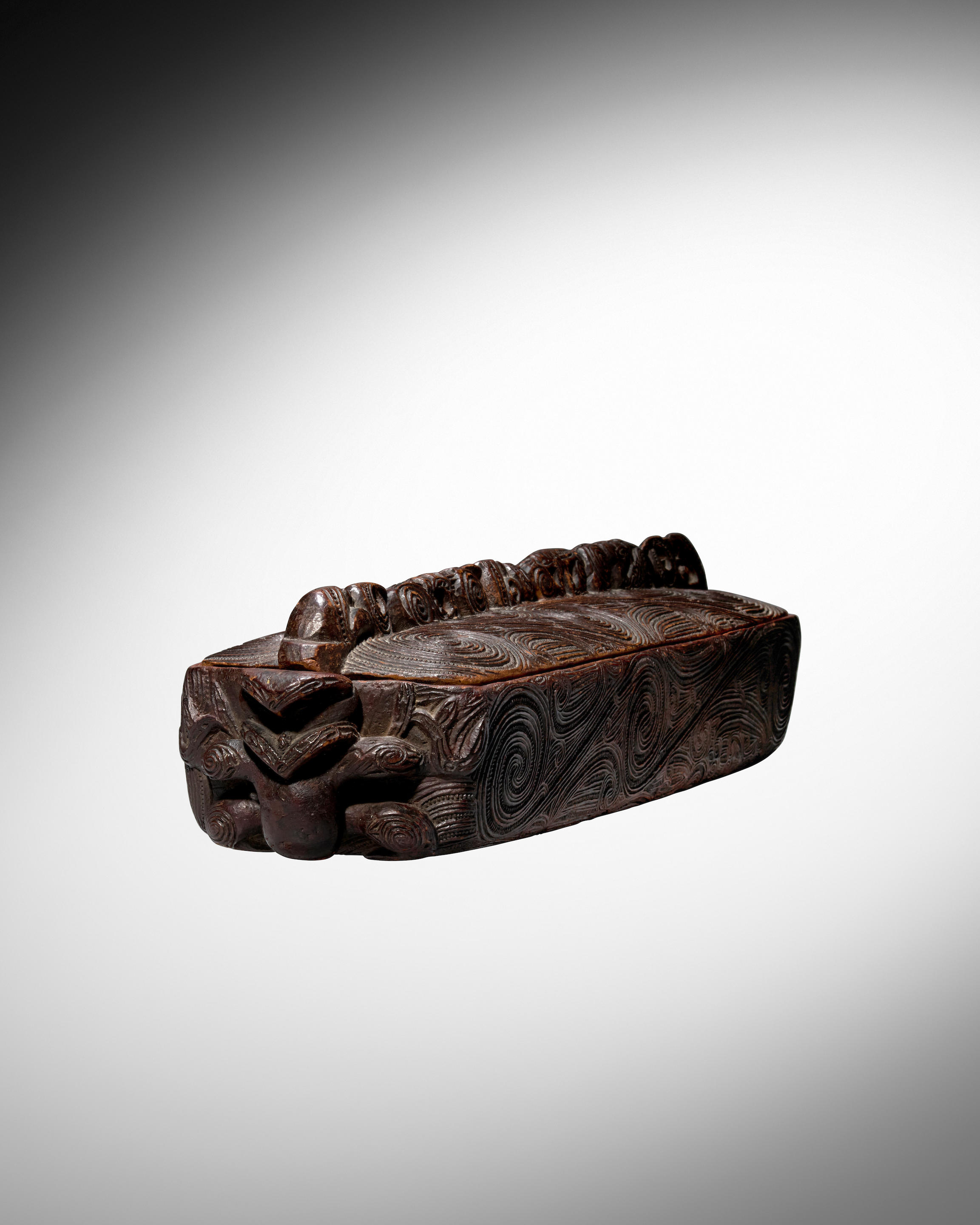
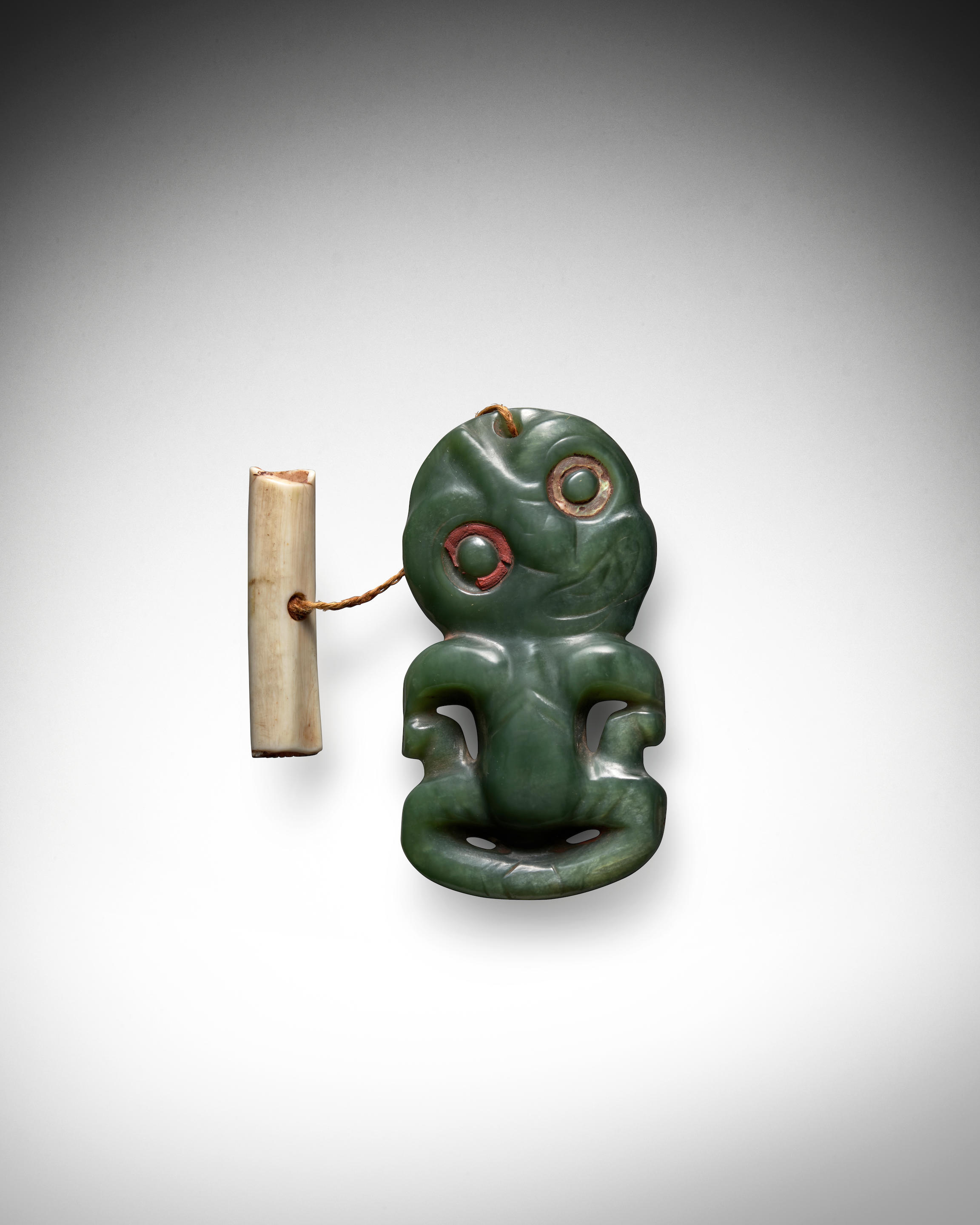

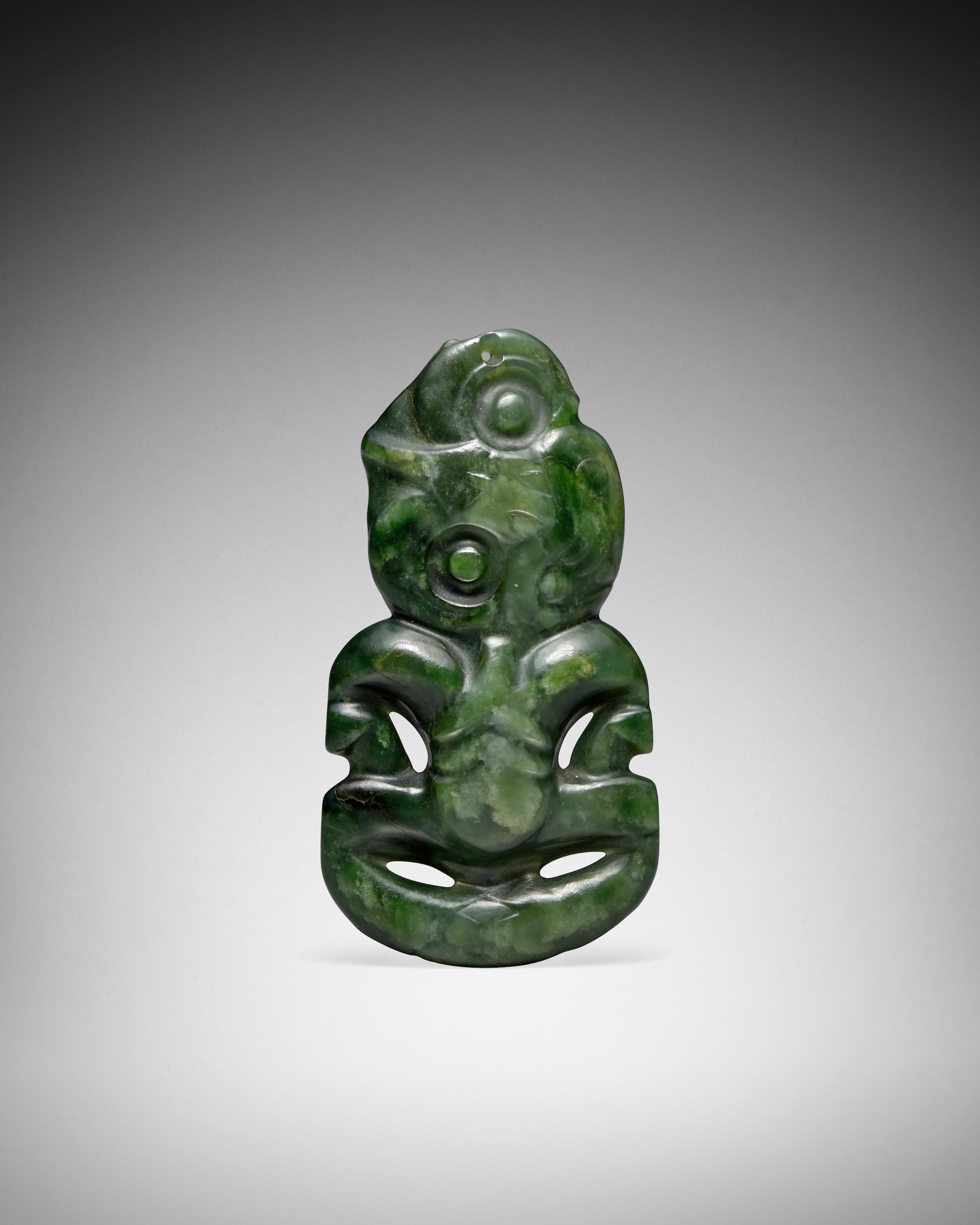
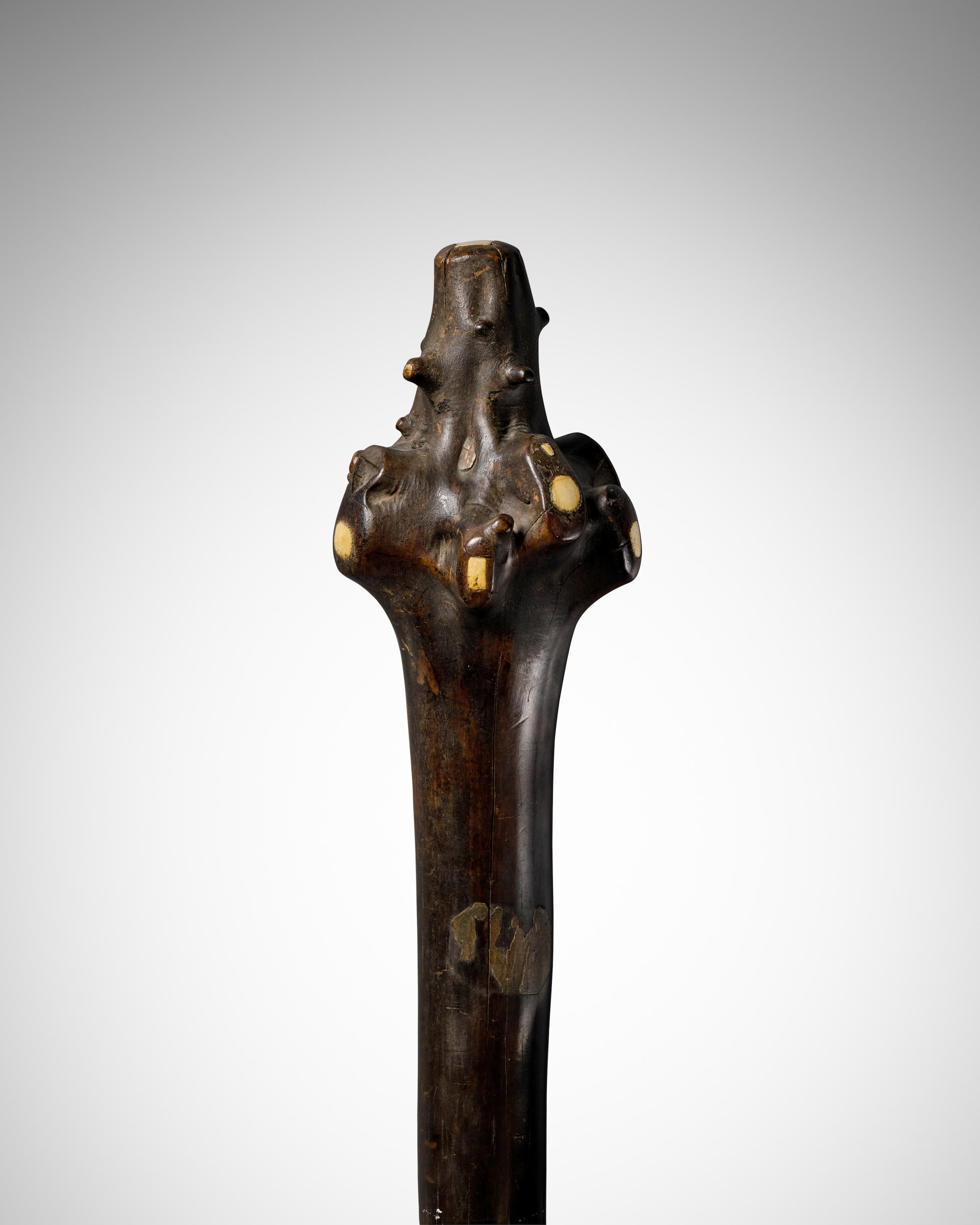
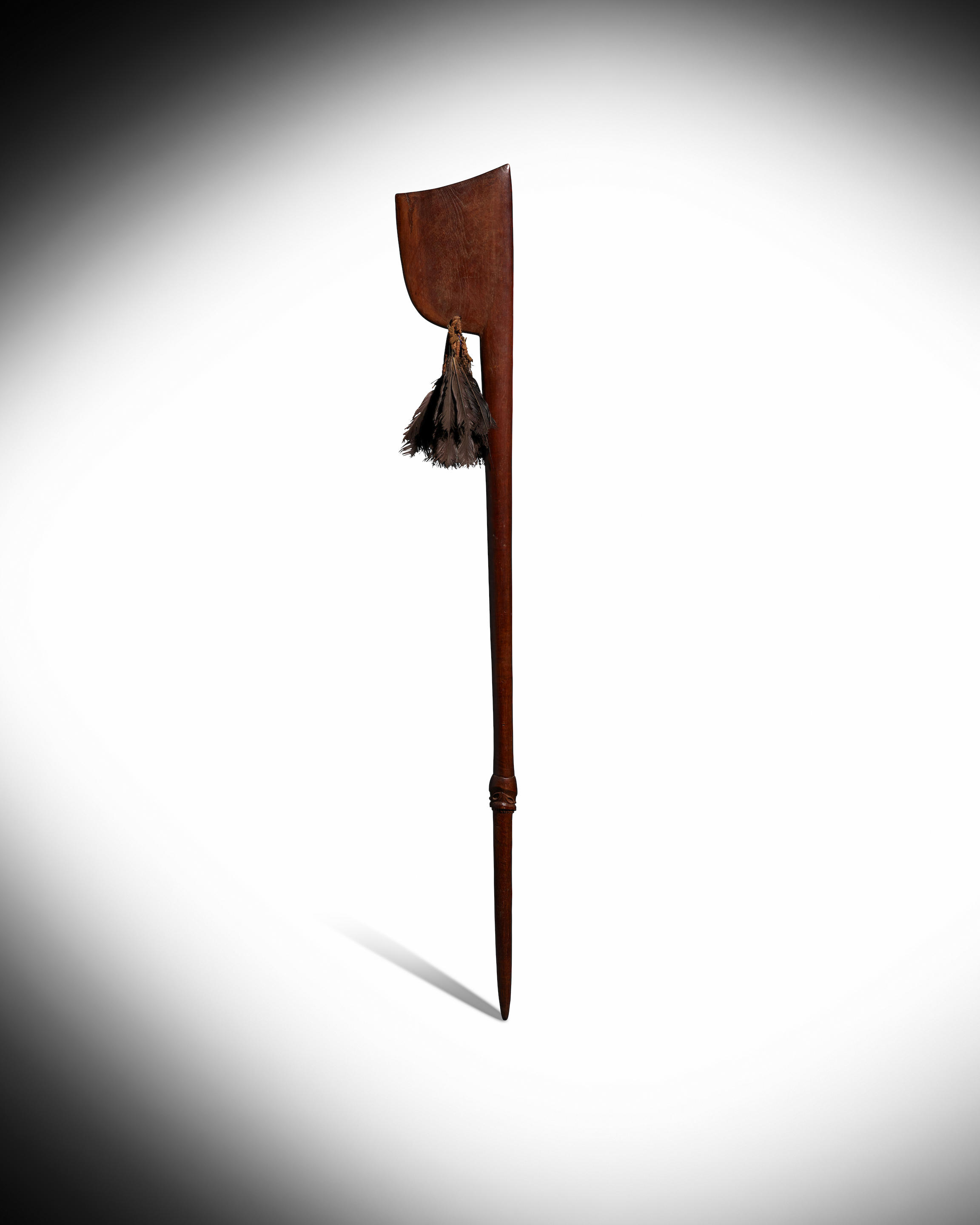
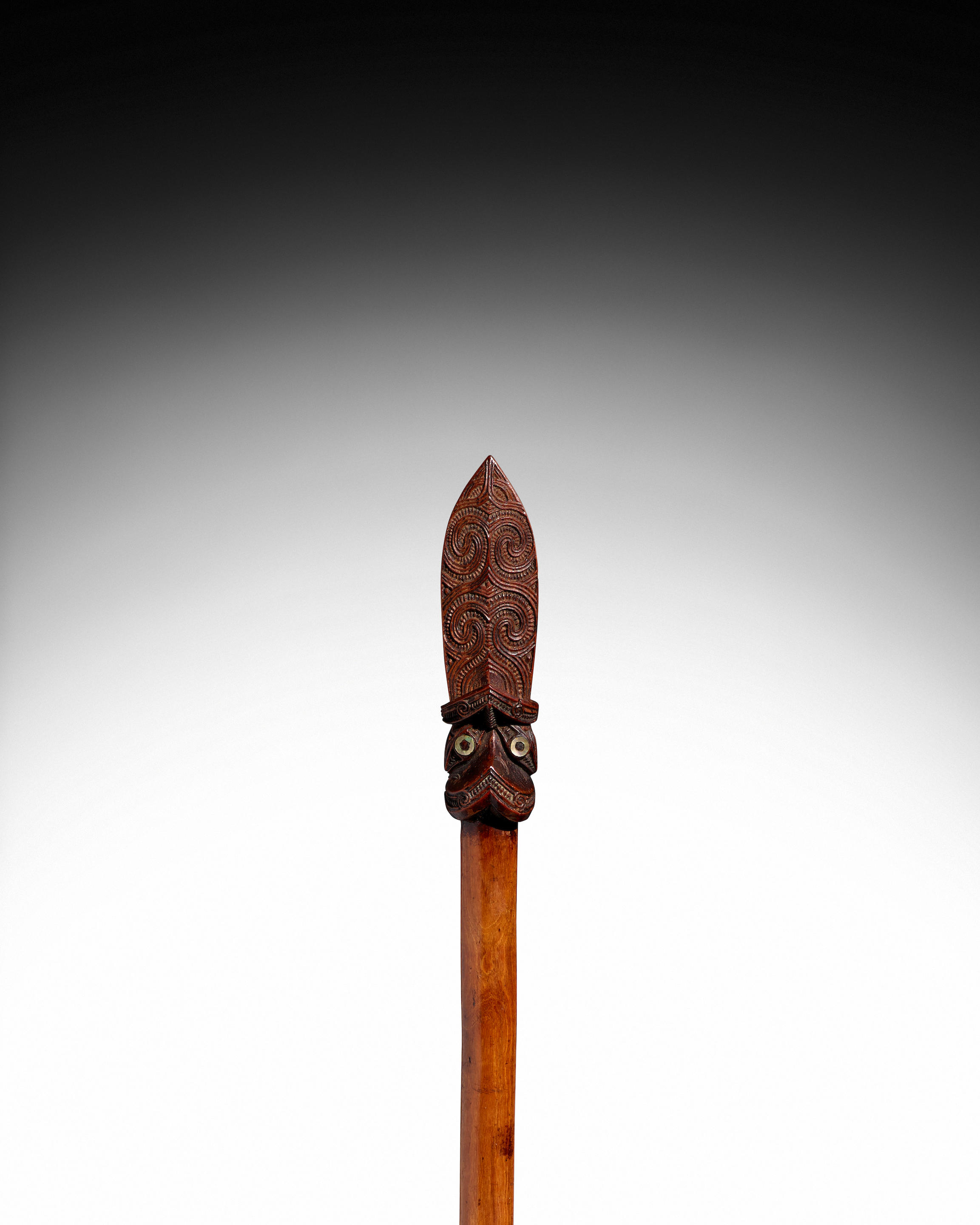
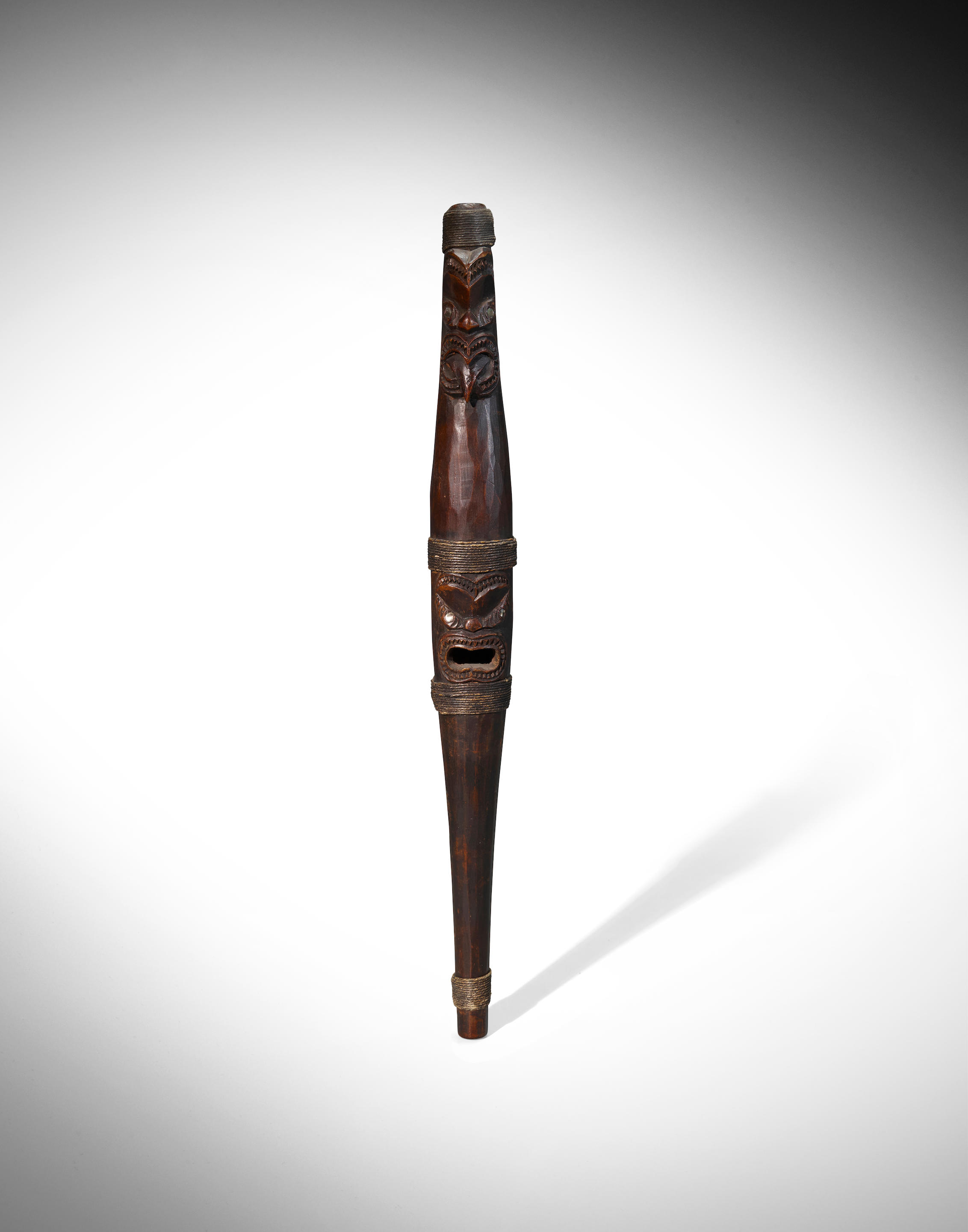
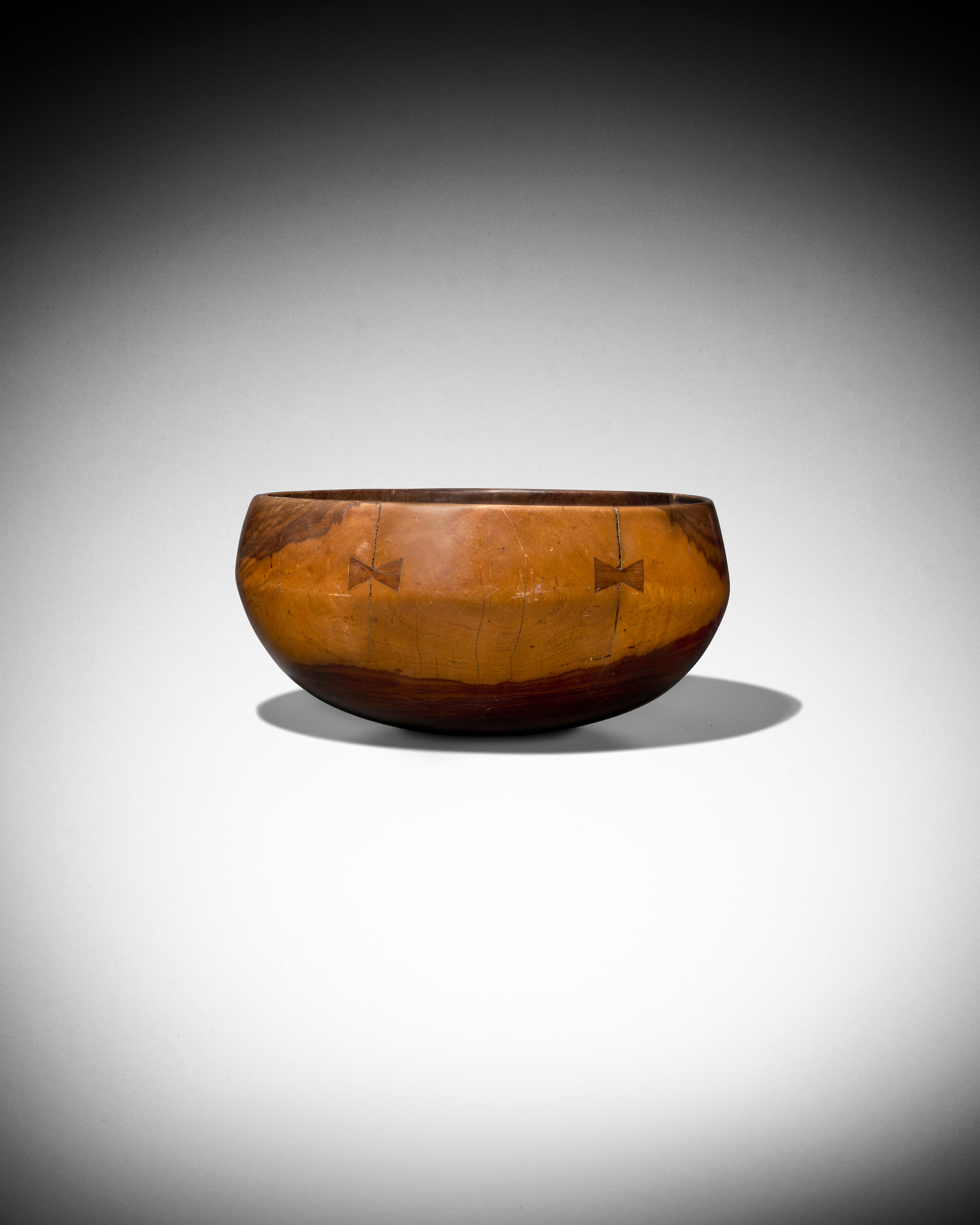
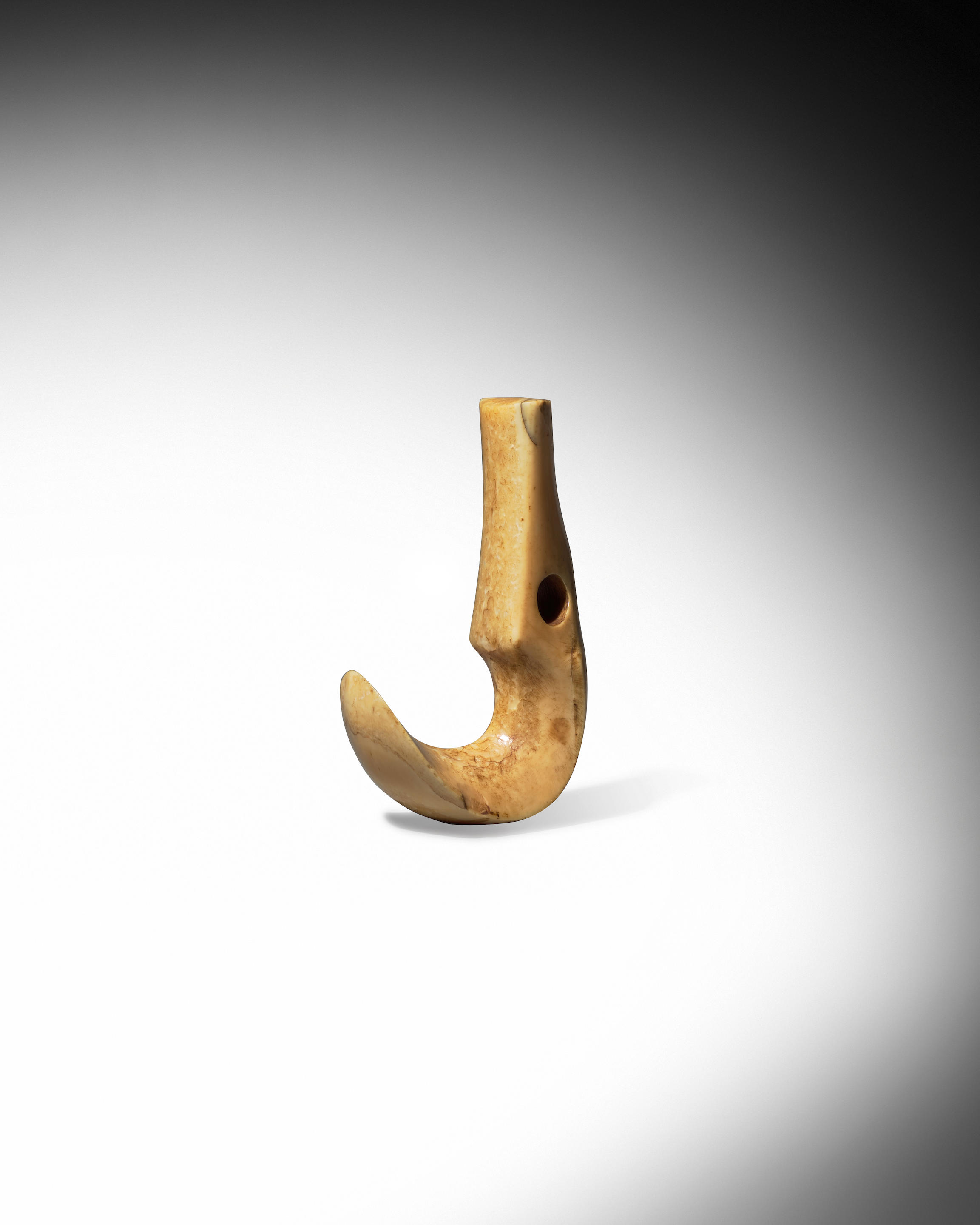
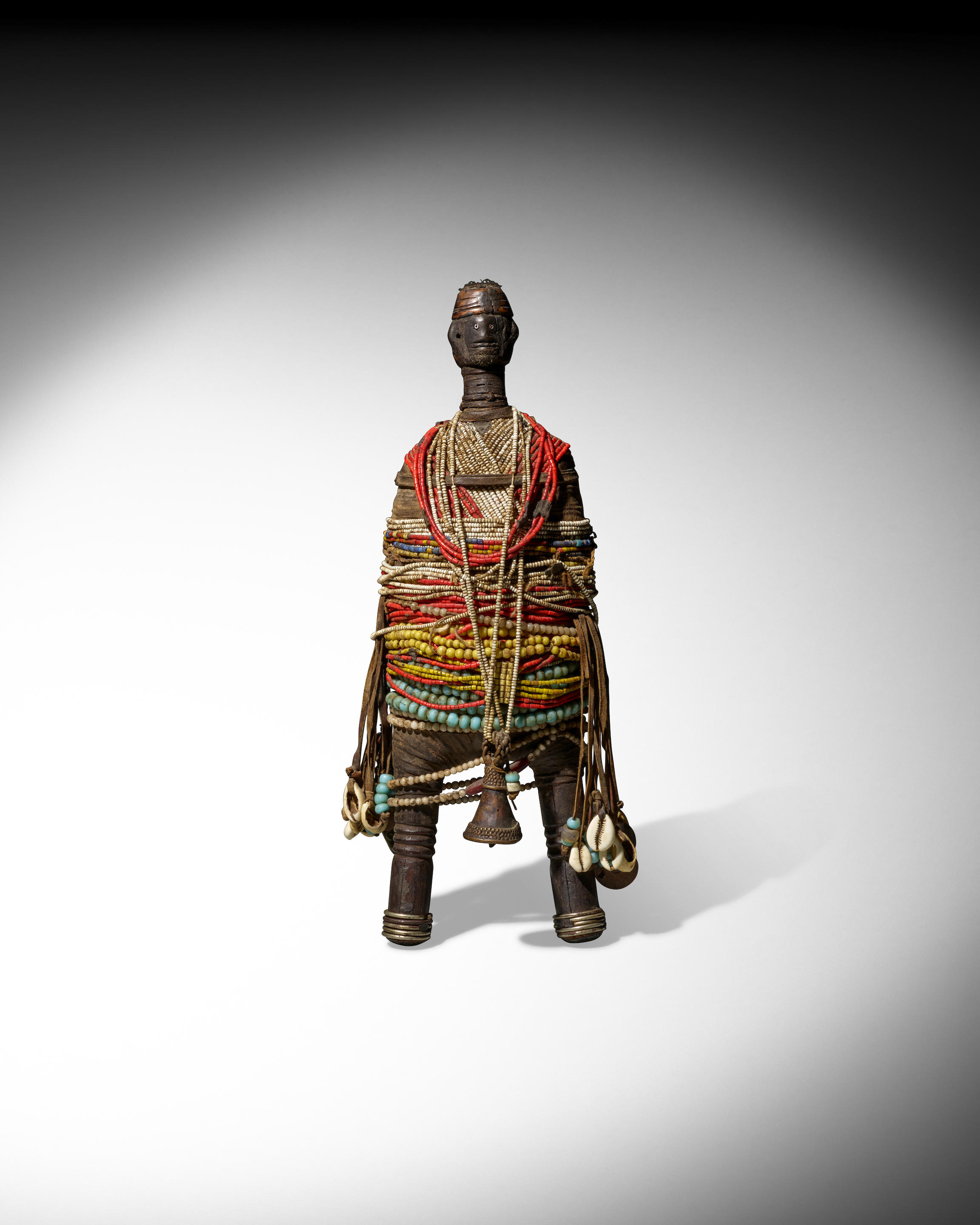
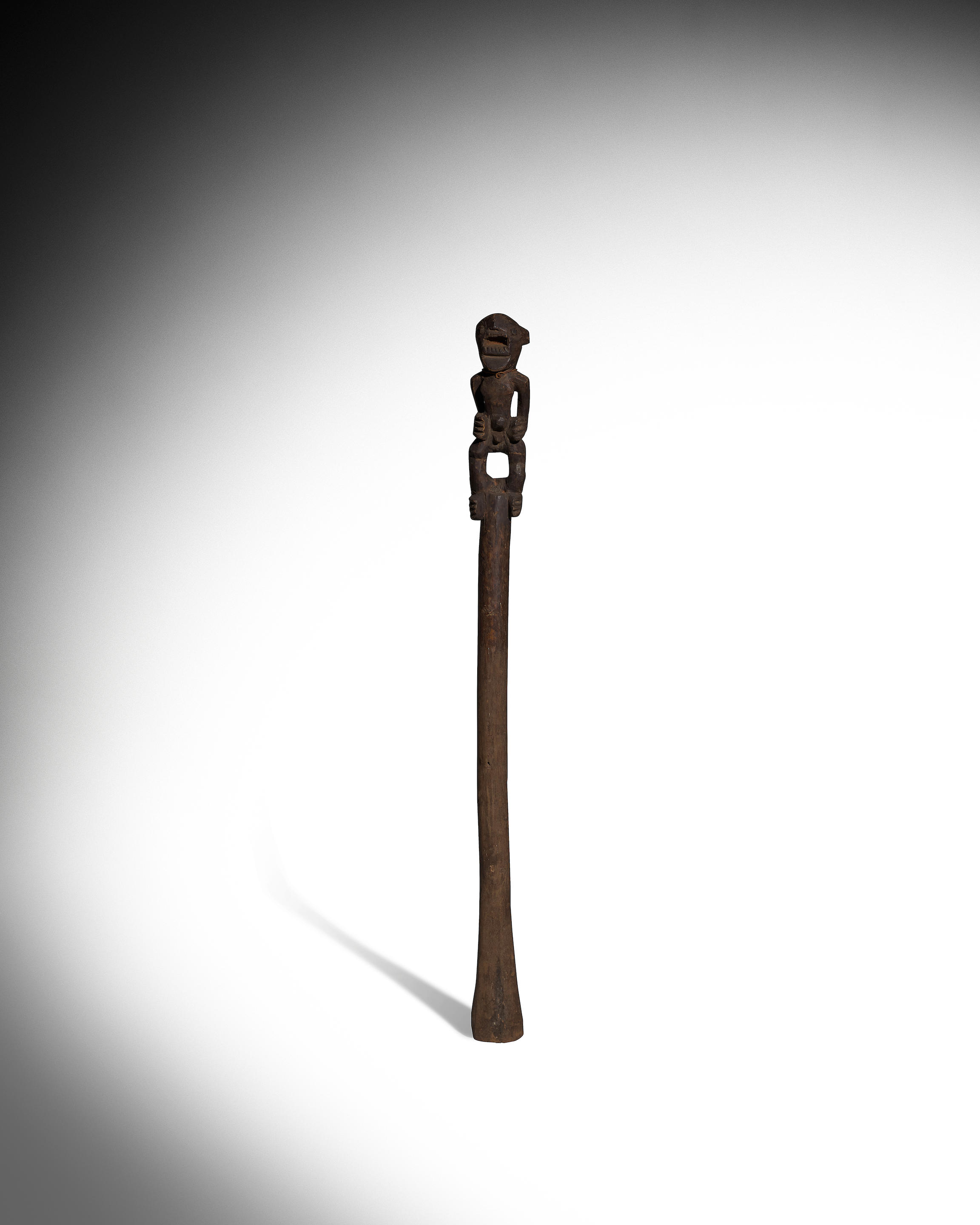
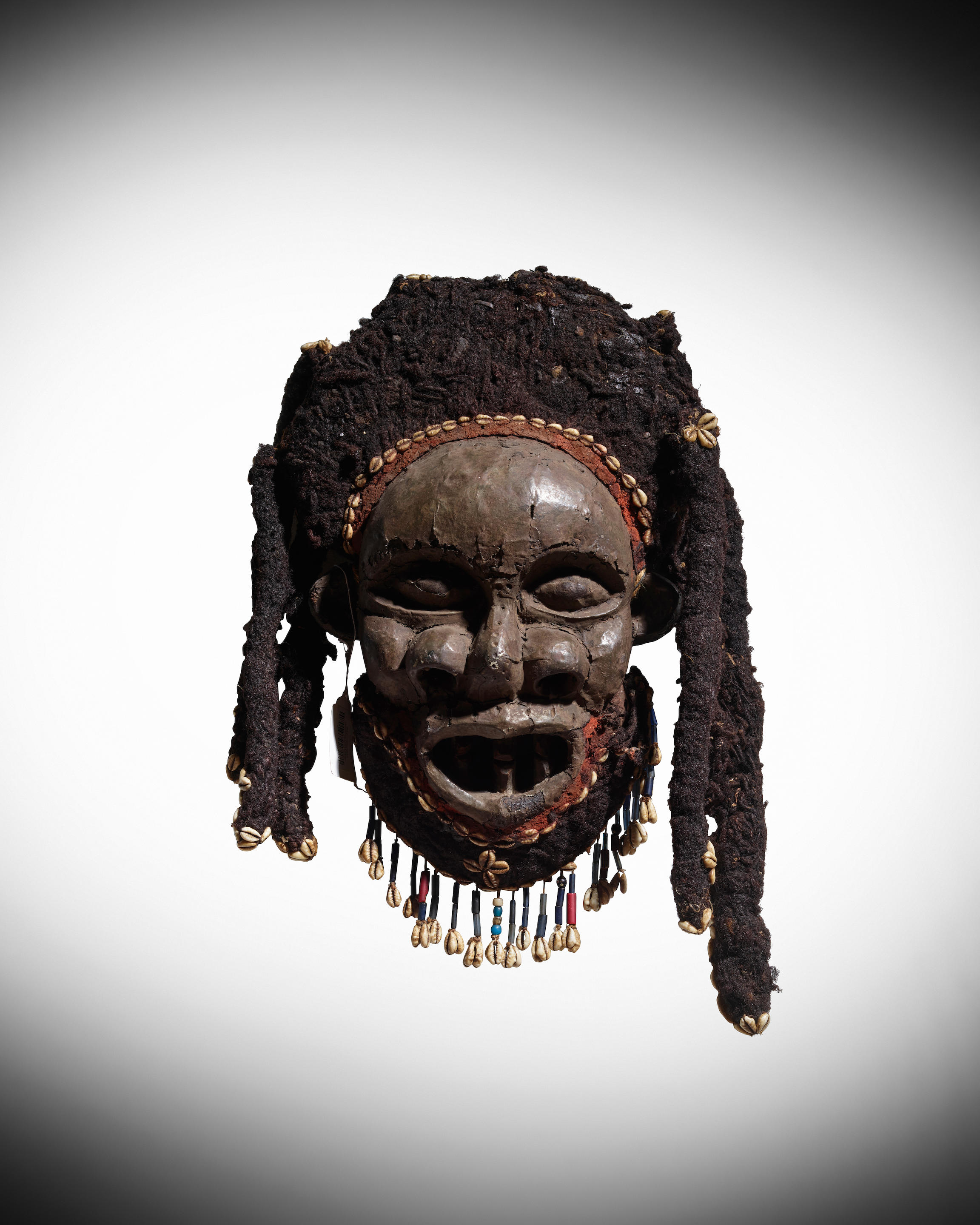
Try LotSearch and its premium features for 7 days - without any costs!
Be notified automatically about new items in upcoming auctions.
Create an alert